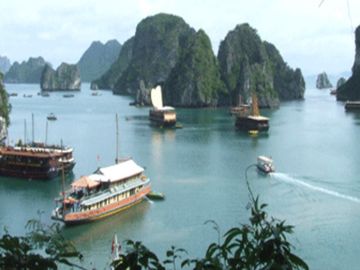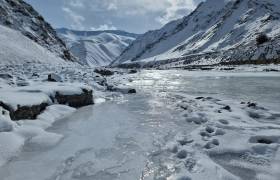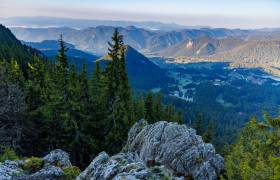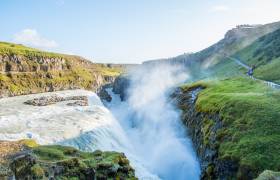Vietnam Activity and Adventure Holidays with Exodus. It was an early morning flight from Bangkok. Excitement was in the air; I was in the air too – just 20 minutes away from my first touch down point in Vietnam, Hanoi. Our plane gradually descended over the lush green patchwork of paddy fields and soon we landed. I said to myself: “Good Morning Vietnam” and it was a good morning in Vietnam.
HANOI
I made my way to the passenger pick up point after a short immigration routine at Noi Bai International Airport, Hanoi. I arrived ahead of the group on a different flight, so after being met at the airport and whisked to the centre of Hanoi to my comfortable hotel, I decided to head straight out to explore the city. Just a few minutes later, I was standing by Ornamental Lake, Hanoi, contemplating work life… (I know I am lucky to be offered this kind of work training – some even say Exodus staff have the best job in the world! I agree…well, kind of…). I wanted to make the most out of my work holiday so resting, after 15 hours of flying, was not on the list of things to do. Hanoi bustles with life and is known for its culture, shopping and food. I wandered through the streets for most of the afternoon and then met the rest of the Exodus group at the hotel where we were briefed about our stay in Vietnam. Halong Bay Early next morning we set off for a four hour drive through the ever changing Vietnamese landscape to visit the Halong Bay. Our driver masterfully negotiated his way through the millions of scooters on busy Hanoi’s roads and took us across the Red River in only an hour or so. We continued driving past the lush green paddy fields for the next two hours before reaching Halong bay. Halong Bay is a UNESCO World Heritage Site located in Quang Ninh province, Vietnam. The bay features thousands of limestone karsts and isles in various sizes and shapes. It was an amazing setting! The emerald green sea provided a perfect backdrop to the lush green limestone island. Before we knew it we were on our boat, which was very clean and was at our disposal for the full 24 hours. We had very tastefully decorated ensuite double rooms with some stunning views of the bay. The staff on board were really good and helpful. They served a gorgeous seafood meal which was much appreciated, while we zigzagged through the network of islands. The Best Bits 1) Boat arranged for us by Exodus – fresh seafood and chilled local beer served 2) Seeing local floating villages and shops 3) Seeing sunset and sunrise from the boat 4) Kayaking through this magical landscape 5) Sung Sot Cave, Ha Long Bay Face to Face with Ho Chi Minh After a big breakfast at the hotel we set off to visit the Ho Chi Minh mausoleum. Ho Chi Minh is still referred to as “Uncle Ho” in Vietnam and is highly respected by most Vietnamese. The mausoleum (built with Soviet help in 1975, six years after Ho’s death) is set on Ba Dinh Square, 2km west of Hoan Kiem Lake, the site where Ho quoted the US Declaration of Independence on September 2, 1945, while starting Vietnam’s 30-year quest for their own independence. As you approach the mausoleum you can see one of Ho’s famous quotes: ‘khong co gi quy hon doc lap tu do’ (‘nothing is more valuable than independence and freedom’). Ho Chi Minh’s House After filing through the mausoleum, we followed the walkway north passing by the (restricted) Presidential Palace. Through the gardens, Ho’s house, is a modest Vietnamese-style home erected on stilts. Ho had it built after defeating the French in 1954. We walked up to peek into his living and working areas. One-Pillar Pagoda The exit from Ho’s house leads via a garden road to one of Hanoi’s most cherished symbols, the tiny One-Pillar Pagoda. The square pond features the unique lone-pillar pagoda – a common spot for couples and families to pose for photographs.
REUNIFICATION EXPRESS TO HUE
We took the famous Reunifcation Express to our next stop Hue – a vibrant town located just next to Perfume River. Later that afternoon we went for a boat trip on the Perfume River and visited a local fishing village and then went on to visit Thien Mu Pagoda – perched on a cliff over the river and housing some very fine gold and silver Buddha images. The Thien Mu Pagoda overlooks the Perfume River and is the official symbol of the city of Hue. The Citadel – HUE Construction of the citadel began in the early 1800s. During 1968 there was heavy fighting in Hue, and much of it was concentrated in the area of the citadel. Consequently much of it was damaged. Within the citadel itself is another, smaller, citadel – the Imperial Enclosure or Forbidden Purple City with walls 6 m high and 2.5 km in length. This functioned largely as a private residence of the emperor, his family and servants. Tomb of Tu Duc We also visited Tomb of Tu Duc which was constructed from 1833 to 1867. The complex served as a second Imperial City where the Emperor went for “working vacations”. Tu Duc’s contemplative nature and poetic spirit is reflected in the landscape and arrangement of the 50 buildings that at one time stood here.
HOI AN – WHERE DOLLARS FLY!
In 1999, the old town was declared a World Heritage Site by UNESCO as a well-preserved example of a Southeast Asian trading port of the 15th to 19th centuries, whose buildings display a unique blend of local and foreign influences. Today, Hoi An is still a small city, but it attracts a fair number of tourists, also being a well established place on the backpacker trail. Many visit for the numerous art and craft shops and tailors, who produce made-to-measure clothes for a fraction of the western price. Dollars do fly here!
SAIGON – HO CHI MINH CITY
I spent the next three days in Saigon. Like the other hotels offered by Exodus, our hotel was ideally located for sightseeing around the city. Notre Dame Cathedral In the heart of downtown Saigon (District 1), next to the main post office, Notre Dame Cathedral stands with a statue ofVirgin Mary in front of it. Sunday Mass begins at 9:30am. The cathedral’s construction took 16 years – from 1877 and 1883. There are two 40-metre high towers that used to dominate Saigon’s skyline until taller structure were built. Ben Thanh Market Saigon’s most famous landmark, this market dates back to the French occupation. The market has been at its present location since 1899. Saigon has about 200 markets. Ben Thanh Market is the most famous. Bargain hard as the prices they quote are normally 300 percent over what they will sell it for. Cu Chi Tunnels A must do excursion for anyone visting Ho Chi Minh City. This is the site of the Cu Chi tunnels, one of the most famous battlegrounds of the Vietnam War. Today it is one of the country’s prime tourist attractions. Cu Chi is a system of tunnels deep underground, with several floors, a labyrinth of intricate ways and windings over 200 km long, with specific sections for accommodations, meetings, hospitals, kitchens etc. Other Tourist attactions around Saigon Giac Lam Pagoda Reunification Palace The War Remnants Museum Dong Khoi Street’s tourist town Cholon – Chinatown
MEKONG DELTA
Our next and final destination in Vietnam was a visit to the mighty Mekong Delta, where we stayed with a local family for a night. From the Tibetean Plateau, Mekong winds its way through China’s Yunnan province, Burma, Thailand, Laos, Cambodia and Vietnam before entering the South China Sea. No visit to the south of Vietnam is complete without spending some time cruising these waters, visiting local villages, floating markets and seeing how the many local delicacies are made. Vietnam simply blew me away! I travelled from Hanoi to Mekong (by road, rail and air) and stayed in half a dozen towns and met a few people along the way. A few things stand out in common across the board with Vietnam and this trip: Value for money. You get unmatched value for your money. (Some pubs serve a good lager for just 12 pence a pint) People. A very friendly bunch Food. It is just out of this world. In fact in Vietnam, food preparation has become an art. Go and treat all senses! Sites. Countless natural and man-made wonders Vietnam Activity & Adventure Holidays with Exodus.
It was an early morning flight from Bangkok. Excitement was in the air; I was in the air too – just 20 minutes away from my first touch down point in Vietnam, Hanoi. Our plane gradually descended over the lush green patchwork of paddy fields and soon we landed. I said to myself: “Good Morning Vietnam” and it was a good morning in Vietnam.
HANOI
I made my way to the passenger pick up point after a short immigration routine at Noi Bai International Airport, Hanoi. I arrived ahead of the group on a different flight, so after being met at the airport and whisked to the centre of Hanoi to my comfortable hotel, I decided to head straight out to explore the city. Just a few minutes later, I was standing by Ornamental Lake, Hanoi, contemplating work life… (I know I am lucky to be offered this kind of work training – some even say Exodus staff have the best job in the world! I agree…well, kind of…). I wanted to make the most out of my work holiday so resting, after 15 hours of flying, was not on the list of things to do. Hanoi bustles with life and is known for its culture, shopping and food. I wandered through the streets for most of the afternoon and then met the rest of the Exodus group at the hotel where we were briefed about our stay in Vietnam. Halong Bay Early next morning we set off for a four hour drive through the ever changing Vietnamese landscape to visit the Halong Bay. Our driver masterfully negotiated his way through the millions of scooters on busy Hanoi’s roads and took us across the Red River in only an hour or so. We continued driving past the lush green paddy fields for the next two hours before reaching Halong bay. Halong Bay is a UNESCO World Heritage Site located in Quang Ninh province, Vietnam. The bay features thousands of limestone karsts and isles in various sizes and shapes. It was an amazing setting! The emerald green sea provided a perfect backdrop to the lush green limestone island. Before we knew it we were on our boat, which was very clean and was at our disposal for the full 24 hours. We had very tastefully decorated ensuite double rooms with some stunning views of the bay. The staff on board were really good and helpful. They served a gorgeous seafood meal which was much appreciated, while we zigzagged through the network of islands. The Best Bits 1) Boat arranged for us by Exodus – fresh seafood and chilled local beer served 2) Seeing local floating villages and shops 3) Seeing sunset and sunrise from the boat 4) Kayaking through this magical landscape 5) Sung Sot Cave, Ha Long Bay Face to Face with Ho Chi Minh After a big breakfast at the hotel we set off to visit the Ho Chi Minh mausoleum. Ho Chi Minh is still referred to as “Uncle Ho” in Vietnam and is highly respected by most Vietnamese. The mausoleum (built with Soviet help in 1975, six years after Ho’s death) is set on Ba Dinh Square, 2km west of Hoan Kiem Lake, the site where Ho quoted the US Declaration of Independence on September 2, 1945, while starting Vietnam’s 30-year quest for their own independence. As you approach the mausoleum you can see one of Ho’s famous quotes: ‘khong co gi quy hon doc lap tu do’ (‘nothing is more valuable than independence and freedom’). Ho Chi Minh’s House After filing through the mausoleum, we followed the walkway north passing by the (restricted) Presidential Palace. Through the gardens, Ho’s house, is a modest Vietnamese-style home erected on stilts. Ho had it built after defeating the French in 1954. We walked up to peek into his living and working areas. One-Pillar Pagoda The exit from Ho’s house leads via a garden road to one of Hanoi’s most cherished symbols, the tiny One-Pillar Pagoda. The square pond features the unique lone-pillar pagoda – a common spot for couples and families to pose for photographs.
REUNIFICATION EXPRESS TO HUE
We took the famous Reunifcation Express to our next stop Hue – a vibrant town located just next to Perfume River. Later that afternoon we went for a boat trip on the Perfume River and visited a local fishing village and then went on to visit Thien Mu Pagoda – perched on a cliff over the river and housing some very fine gold and silver Buddha images. The Thien Mu Pagoda overlooks the Perfume River and is the official symbol of the city of Hue. The Citadel – HUE Construction of the citadel began in the early 1800s. During 1968 there was heavy fighting in Hue, and much of it was concentrated in the area of the citadel. Consequently much of it was damaged. Within the citadel itself is another, smaller, citadel – the Imperial Enclosure or Forbidden Purple City with walls 6 m high and 2.5 km in length. This functioned largely as a private residence of the emperor, his family and servants. Tomb of Tu Duc We also visited Tomb of Tu Duc which was constructed from 1833 to 1867. The complex served as a second Imperial City where the Emperor went for “working vacations”. Tu Duc’s contemplative nature and poetic spirit is reflected in the landscape and arrangement of the 50 buildings that at one time stood here.
HOI AN – WHERE DOLLARS FLY!
In 1999, the old town was declared a World Heritage Site by UNESCO as a well-preserved example of a Southeast Asian trading port of the 15th to 19th centuries, whose buildings display a unique blend of local and foreign influences. Today, Hoi An is still a small city, but it attracts a fair number of tourists, also being a well established place on the backpacker trail. Many visit for the numerous art and craft shops and tailors, who produce made-to-measure clothes for a fraction of the western price. Dollars do fly here!
SAIGON – HO CHI MINH CITY
I spent the next three days in Saigon. Like the other hotels offered by Exodus, our hotel was ideally located for sightseeing around the city. Notre Dame Cathedral In the heart of downtown Saigon (District 1), next to the main post office, Notre Dame Cathedral stands with a statue ofVirgin Mary in front of it. Sunday Mass begins at 9:30am. The cathedral’s construction took 16 years – from 1877 and 1883. There are two 40-metre high towers that used to dominate Saigon’s skyline until taller structure were built. Ben Thanh Market Saigon’s most famous landmark, this market dates back to the French occupation. The market has been at its present location since 1899. Saigon has about 200 markets. Ben Thanh Market is the most famous. Bargain hard as the prices they quote are normally 300 percent over what they will sell it for. Cu Chi Tunnels A must do excursion for anyone visting Ho Chi Minh City. This is the site of the Cu Chi tunnels, one of the most famous battlegrounds of the Vietnam War. Today it is one of the country’s prime tourist attractions. Cu Chi is a system of tunnels deep underground, with several floors, a labyrinth of intricate ways and windings over 200 km long, with specific sections for accommodations, meetings, hospitals, kitchens etc. Other Tourist attactions around Saigon Giac Lam Pagoda Reunification Palace The War Remnants Museum Dong Khoi Street’s tourist town Cholon – Chinatown
MEKONG DELTA
Our next and final destination in Vietnam was a visit to the mighty Mekong Delta, where we stayed with a local family for a night. From the Tibetean Plateau, Mekong winds its way through China’s Yunnan province, Burma, Thailand, Laos, Cambodia and Vietnam before entering the South China Sea. No visit to the south of Vietnam is complete without spending some time cruising these waters, visiting local villages, floating markets and seeing how the many local delicacies are made. Vietnam simply blew me away! I travelled from Hanoi to Mekong (by road, rail and air) and stayed in half a dozen towns and met a few people along the way. A few things stand out in common across the board with Vietnam and this trip: Value for money. You get unmatched value for your money. (Some pubs serve a good lager for just 12 pence a pint) People. A very friendly bunch Food. It is just out of this world. In fact in Vietnam, food preparation has become an art. Go and treat all senses! Sites. Countless natural and man-made wonders




